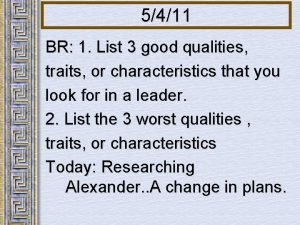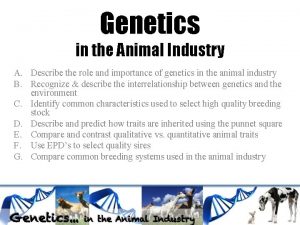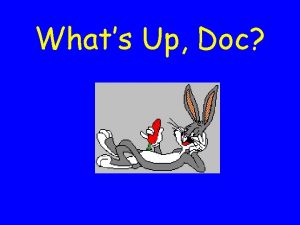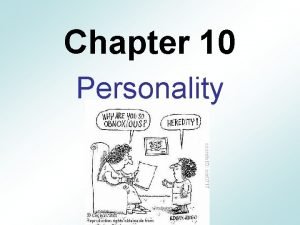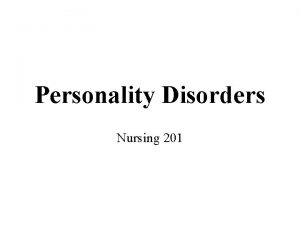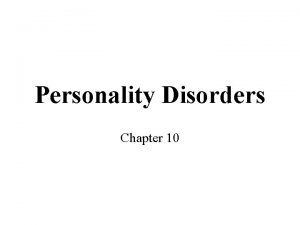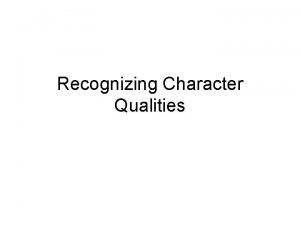PERSONALITY PATTERNS Concept The traits specific qualities of














- Slides: 14

PERSONALITY PATTERNS

Concept � The traits (specific qualities of behavior, which characterize individual’s unique adjustment to life) are organized and integrated into a meaningful pattern. � The centre of gravity of the personality pattern is individual’s concept of himself as a person as related to the world in which he lives.

Development of personality pattern � Three major factors that determine development of personality pattern are: �Individual’s hereditary endowment �Early experiences within the family �Important events outside the home environment

Role of heredity � Personality pattern is determined by physical and mental characteristics (intelligence, temperament). These are the result of heredity. � It is stressed because, for example, a person who inherits a low grade intelligence cannot even under most favorable environmental conditions develop a good personality pattern.

Role of Learning � Social pressure within and outside the home determine certain traits which will be incorporated into the pattern. � Learning tells us that the individual will develop the kind of personality pattern that will lead to good personal and social adjustments. � Learning tells us that unhealthy self concepts and socially unacceptable patterns of adjustment can be changed and modified.

Elements of Personality Pattern � Concept of Self: �Core or centre of gravity � Personality traits: �Integrated system of learned responses.

Concept of Self � It refers to attitude toward self. � Those perceptions, beliefs, feelings, attitudes and values which the individual views as part or characteristics of himself. � Components: �Perceptual component: Image that a person has of appearance of his body and of the impression he make on the others. �Conceptual component: Person’s abilities, disabilities, his background and his future. �Attitudinal component: Feelings of a person about himself.

Types of self concept � Basic self concept: Real self � Transitory self concept: A person who is well and happy, who is accepted by others, and who achieves what he has set out to do may have transitory self concept that is more favorable than his basic self concept. � Social self concept � Ideal self concept

Personality Traits � Trait theory visualizes personality as a reflection of certain traits of the individual. � Every trait has three characteristics: �Uniqueness �Degree of likableness �Consistency � Common and Unique traits �Common traits are qualities that are found in most people within a cultural group. �Unique traits are patterns of behavior which characterize a particular individual and may not be found or found to the some degree in other people.

Personality Traits � Number of traits: Many attempts have been made to discover how many traits a typical personality pattern contains. �Cattell listed 171 personality traits. Further these traits were reduced and divided into two categories: surface and source traits.

Cattell’s Personality Traits � • Surface traits: Personality characteristics easily seen by other people (one’s outward actions). � • Source traits: More basic traits that underlie the surface traits. � Example of the 2 working together: Shyness, being quiet, and disliking crowds are surface traits related to the more basic source traits of introversion

Cattell’s Personality Traits � � � � Warmth Reasoning Emotional Stability Dominance Liveliness Rule consciousness Social boldness Sensitivity � � � � Vigilance Abstractedness (imaginative vs practical) Privateness Apprehension (Self Assured vs Self doubting) Openness to change Self reliance Perfectionism Tension

Personality Traits � Big five personality traits �Agreeableness: Ability to get along with others �Conscientiousness: Number of goals on which a person focuses his attention �Negative emotionality: Refers to more excitable, insecure, reactive and subject to extreme mood swings �Extroversion: Degree of extroversion reflects a person’s comfort level with relationships �Openness: Person’s rigidity of beliefs and range of interests.

Personality Traits � Other personality traits �Self-concept and Self-esteem �Machiavellianism: Manipulation of others as a primary way of achieving one’s goals. �Locus of Control: Whether people believe that they are in control of events (external locus), or they control events (internal locus) �Tolerance for ambiguity �Type A and B: Type A always feel a sense of time urgency, are highly achievement oriented, exhibit competitive drive and are impatient when their work is slowed down for any reason. �Work-ethic Orientation: Refers to involvement in the job. �Risk propensity
 3 good qualities
3 good qualities Inheritance of quantitative traits
Inheritance of quantitative traits Qualitative traits vs quantitative traits
Qualitative traits vs quantitative traits Qualitative traits vs quantitative traits
Qualitative traits vs quantitative traits Glycerin specific gravity
Glycerin specific gravity Specific gravity to specific volume
Specific gravity to specific volume Sociologists define a symbol as
Sociologists define a symbol as Bugs bunny trickster
Bugs bunny trickster Personality definition
Personality definition Atticus finch character traits
Atticus finch character traits Thor character description
Thor character description Dally winston character traits
Dally winston character traits The outsiders character list
The outsiders character list Abigail williams the crucible description
Abigail williams the crucible description Squidward gender
Squidward gender
